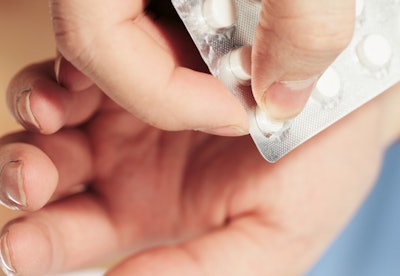
According to a recent pharma packaging market report by Future Market Insights, protective measures have gained centerstage with emphasis on “greater design flexibility, break-resistance, and improved barrier thresholds that continue to drive material advancements.”
The report notes blisters, vials, and ampoules will remain the next most preferred types of pharmaceutical packaging after bottles. Some companies have developed systems to make traditional blisters more protective using active packaging technologies.
Recently, FreeThink Technologies, Inc., Aptar CSP Technologies, and PCI Pharma Services collaborated on a research study comparing the efficacy of Activ-Blister packaging configurations with cold-form foil in maintaining the stability of a model tableted drug product. They also sought to:
- Examine the role of starting water content in the efficacy of Activ-Blister packaging configurations.
- Demonstrate that Accelerated Stability Assessment Program (ASAP) and Freethink’s ASAPprime software can accurately model packaging configurations incorporating molecular sieve and silica gel versions of Activ-Blister packaging and predict the shelf-life of a product using Activ-Blister technology.
ASAP study details
A model drug product was produced and an ASAP study was carried out in which the growth of the main degradant of the active ingredient was quantified. The data was modeled using ASAPprime software and included four different packaging configurations tested under four typical ICH storage conditions (Table 1, RH denotes relative humidity).
- Cold-form foil blisters
- Thermoform incorporating Activ-Blister technology with molecular sieve
- Thermoform incorporating Activ-Blister technology with silica gel and
- Thermoform blisters alone
 Table 1: Blistering and storage conditions used for the stability study.
Table 1: Blistering and storage conditions used for the stability study.
Two different initial relative humidities were modeled to assess how starting water content would impact shelf-life. To confirm the modeling results, tablets were packaged and stored under these conditions for up to 6 months prior to analysis. The companies report:
- Tablets were stressed (open) over a temperature range of 35°C - 60°C and a relative humidity range of 11% RH - 75% RH.
- Related substances were quantified by HPLC and the growth of the main degradant modeled. A good model was obtained with activation energy (i.e. temperature sensitivity) and moisture sensitivity values in the average range for similar products.
PCI performed the blister packaging for the two categories: (1) low RH, where tablets were stored in the presence of silica gel desiccant until blistering and (2) high RH, where tablets were placed in a 25°C/60% RH stability chamber for 24 hours before blistering.
Blistered tablets were stored in reach-in stability chambers (Darwin PH030) at FreeThink Technologies.
Key takeaways
As the ASAP study had predicted, the packaging configurations were ranked in the following way from most protective against degradation to least protective of the model tablet:
- Activ-Blister technology with molecular sieve
- Activ-Blister technology with silica gel
- Coldform foil
- Thermoform blister alone
Figure 1 shows growth of the main degradant in tablets stored under various conditions.
 Figure 1: Probability of passing with a 2-yr shelf life at 25°C/60% RH, 30% dosage RH: Molecular sieve: 99%, Silica gel: 95%, Cold-form foil: 71%, Thermoform alone: 24%. Activ-Blister™ with molecular sieve results in the lowest degradant growth. The impact of Activ-Blister™ packaging configurations is highest with high dosage RH (60% RH).
Figure 1: Probability of passing with a 2-yr shelf life at 25°C/60% RH, 30% dosage RH: Molecular sieve: 99%, Silica gel: 95%, Cold-form foil: 71%, Thermoform alone: 24%. Activ-Blister™ with molecular sieve results in the lowest degradant growth. The impact of Activ-Blister™ packaging configurations is highest with high dosage RH (60% RH).
The ASAPprime program was found to be effective at modeling packaging configurations incorporating molecular sieve and silica gel versions of Activ-Blister (Figure 2).
 Figure 2: Selected ASAPprime predictions compared to degradant growth in tablets stored under ICH stability conditions. The blue lines show the mean prediction while green and red lines show the 95% confidence interval. The 40°C/75% RH conditions have differing scales due to the wide range of degradation.
Figure 2: Selected ASAPprime predictions compared to degradant growth in tablets stored under ICH stability conditions. The blue lines show the mean prediction while green and red lines show the 95% confidence interval. The 40°C/75% RH conditions have differing scales due to the wide range of degradation.























